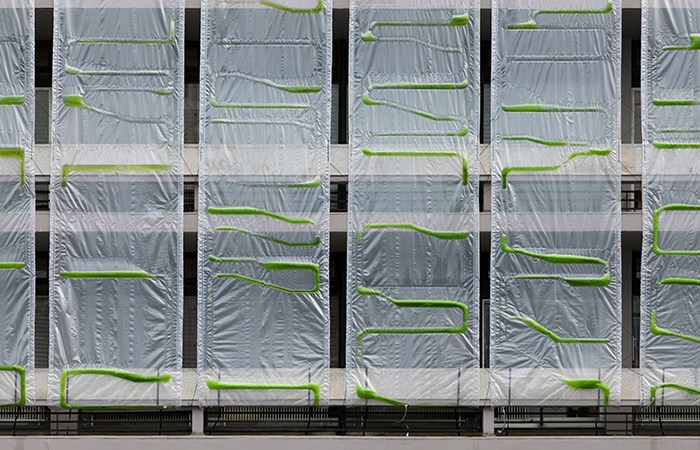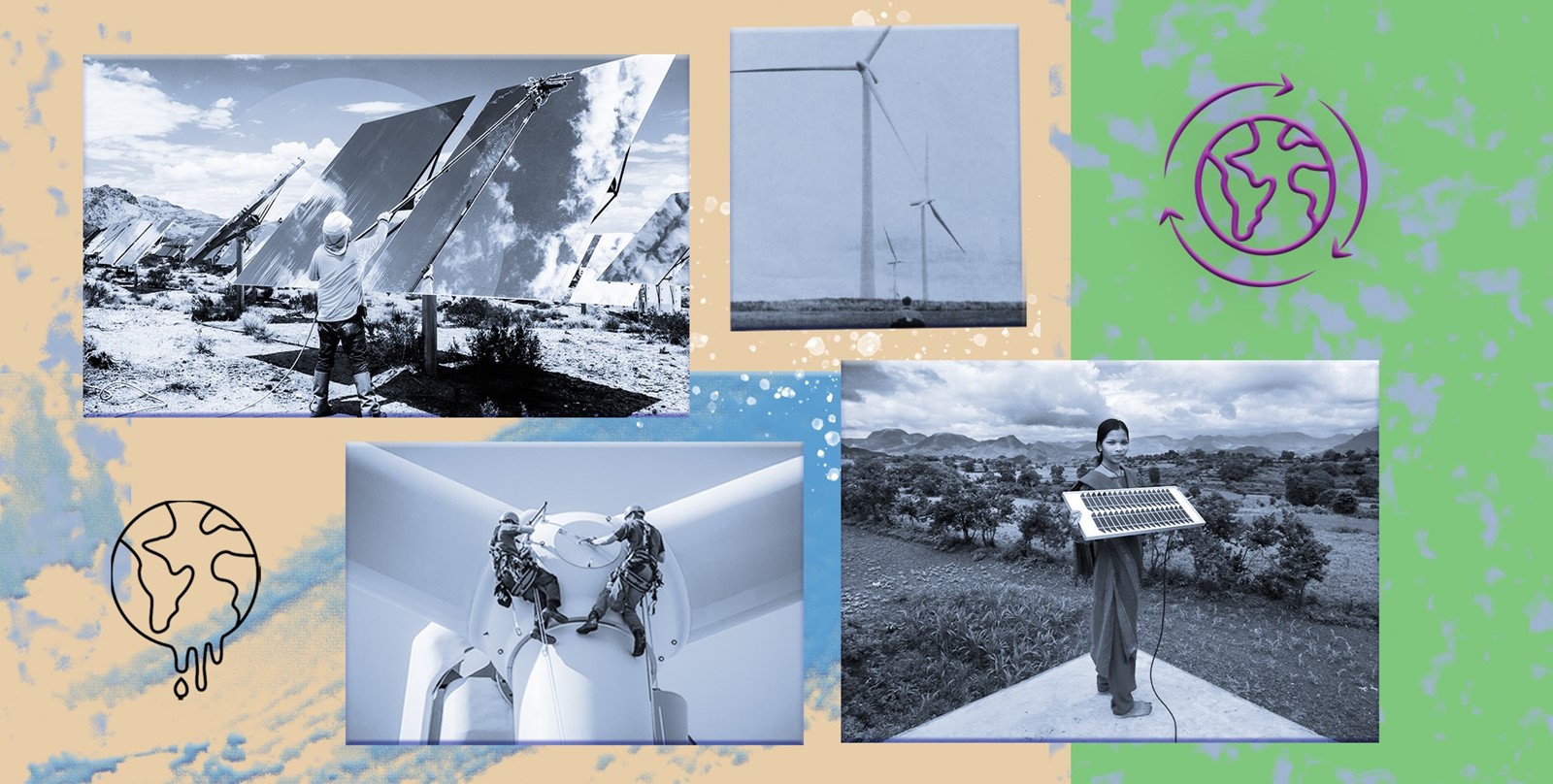Renewable, eco-friendly tech isn’t the stuff of futurist sci-fi – it already exists, and it’s time to make the switch away from deadly fossil fuels
Imagine a future where your daily commute is powered by a simple plug-in charger rather than a gas-guzzling tank full of expensive, smoggy petrol. In this future, the moss-covered cells that clad the building you work in (four days a week, naturally) sink the city’s carbon monoxide, keeping the air you breathe fresh and clean. Once you’re back home, ready to relax, the electricity that brings your TV to life comes from the transparent solar panels that double up as your windows, and the water you bathe in is heated and recycled by a green combi boiler that runs on household waste rather than shale-fracked gas.
With enough political will, this future could be our present. The eco-friendly alternatives outlined above aren’t fiction, but examples of working reality – tangible, viable solutions ripe for investments and roll-out trials. Renewable technologies are a thrilling proposition for those of us invested in a zero-carbon future. And with the climate change emergency facing us now officially recognised by UK parliament, it seems like the powers that be might finally listen to what green tech experts have been telling us all along: a decarbonised future is not only possible, but essential.
Ferocious lobbying by the fossil fuel industry has ensured that renewables – technologies such as solar, wind and water – have been intentionally underfunded by world governments. Here in Britain, for example, the renewables sector has contended with major funding and subsidy cuts since the Tories took power in 2010, while in the US, Trump denies climate change even exists, sabotaging scientific evidence and conservation efforts.
But the tide is finally turning. For the first time, the majority of risk-averse global investors funds are now factoring in the financial cost of climate destruction – and if Labour’s recently launched Green New Deal comes to fruition, it’s likely that solar, wind and water power will flourish, while fossils fuels are phased out. From wind turbines and hydro dams to solar panels and batteries, countless recent examples have shown how successful and innovative renewables can be. An abundance of emerging innovations are also reason for hope.
GREEN SOLUTIONS
With air pollution at deadly, often illegal levels, cleaning up our roads is a pressing issue. Electric cars and vehicles that run on clean, renewable energy are an increasingly viable option given breakthroughs in clean power sources such as the sonnenCharge, a universal electric vehicle charger-slash-battery, and eRoadArlanda, a Swedish project that hopes to create roads that will charge vehicles on the go.
Breakthrough research into the production of biofuels – sustainable, low-carbon, green-powered alternatives to petroleum-based fuel – also continues, promising to make air travel significantly less environmentally damaging.
On our seas, 100 per cent renewable-powered boats are now a very real proposition, and while marine (wave and tidal-powered) technology may be the least developed and currently most expensive field of renewables, hybrid designs such as Thailand’s ‘floatovoltaic’ farm at Sirindhorn Dam – which combines dam-powered turbines alongside floating solar panels – is proof of hydro tech’s untapped potential. It’s even been posited by some experts that, with the right amount of investment, wave power could provide up to 25 per cent of US electricity in the future.

LIVING ARCHITECTURE
Our roads, skies and seas can all benefit from clean, renewable technology, but the buildings we erect and inhabit are also ripe for radical makeovers. Rachel Armstrong, professor of Experimental Architecture at Newcastle University, is interested in ‘living’ architecture: that is, biologically powered, eco-responsible solutions to powering and regulating our homes and cities.
Rachel cites innovations such as bio-concretes – traditional concrete mixes that are modified and impregnated with infrastructure-prolonging microbial spores – and clever building cladding materials such as ecoLogic Studio’s ’little green cows’: units of algae that, with the right application, can produce fuel, provide shading and sink carbon. Then there are cutting edge building blocks such as Suzanne Lambert’s bio-bricks; while traditional brick production causes huge CO2 emissions, bio-bricks are made from human urine, loose sand and living bacteria – a low-cost, low-emissions alternative.
“Speaking of effective use of waste, perhaps my favourite is the University of the West of England’s ‘Pee Power’ project,” says Rachel, “which uses an ’organic’ battery system that turns urine into electricity, as well as cleaning water in the process. It has been powering urinals at Glastonbury for the last three years. It’s supported by Oxfam and Dunster House through a collective effort to improve lives in refugee camps and areas of the world with no sanitation or electricity.”
“No one renewable technology genre, even solar, can meet humanity’s combined energy footprint” – Melissa Sterry
WASTE NOT, WANT NOT
Rachel’s Living Architecture project*, which began in 2016, draws inspiration from Philips’s "Microbial Home” (2011), which imagined a kitchen powered by its own waste. Living Architecture’s version of this vision is centered on an organic processor: a kind of next-level super combi boiler.
In place of the usual fossil fuels, the organic processor runs on household waste, recycling and converting our bathroom waste (urine, faeces) and grey water (run-off from washing machines, baths and sinks etc) to produce clean water, electricity and oxygen and even soap.
The processor does this using a microbial fuel cell (an organic battery like the one mentioned above, in the Pee Power project), an algae bioreactor (an algae powered carbon farm) and a genetically modified processor. “This is the ‘metabolic app’,” explains Rachel. “In other words, this is programmable biology that will allow you to specify what your home organic processor will make. Want biodegradable soap? Want to remove oestrogen from the waste water so it doesn’t go into our rivers? This unit of programmable microbes will do that for you.”
SOLAR, SO GOOD
The Living Architecture processor relies on a number of processes, including solar – a renewables field with plenty of promise. Until recently, solar panels were dark, cumbersome and often expensive things, relegated to out-of-sight places such as rooftops. But recent breakthroughs have given rise to clear, white and even coloured panes that fit on both flat and curved surfaces, meaning these photosynthesis-mimicking panels can now be used almost anywhere – customised, integrated and hidden in plain sight while powering everything from laptops and buses to homes and businesses.
Melissa Sterry, a design scientist and systems theorist, is a staunch advocate of solar power. “For me, it’s the most exciting, because it has the widest possible reach. In terms of potential, the major players in the energy sector all recognise that solar is the most scalable option. Hence, hefty research and development investment, which is enabling leaps in productivity of solar technologies, together with the distribution and storage networks that bring energy to our homes and businesses.”
“When helped rather than hindered, nature is its own self-regulating renewable tech, with built-in protections and sustainable solutions that benefit all living things”
AN INTEGRATED SYSTEM
Solar alone isn’t the answer, says Sterry. “No one renewable technology genre, even solar, can meet humanity’s combined energy footprint. To simultaneously migrate away from fossil fuels while maintaining the living standards many are accustomed to and others aspire to, we have to create a highly complex energy production and distribution infrastructure that integrates not one, but many types of renewables, ranging from the micro to industrial in scale.”
With dire warnings about the countdown to irreversible climate destruction now ringing loud, it’s clear that switching from dirty fossil fuels to clean, green renewables is our best hope of survival. But investment into this historically stymied field must pick up speed. Experts on the front line all agree that while the renewable rollout is accelerating, it’s not happening fast enough to avert the disaster we’re on course for.
NATURE: THE ORIGINAL RENEWABLE TECHNOLOGY
While technological interventions are clearly essential, nature itself also holds the key to our survival. When helped rather than hindered, nature is its own self-regulating renewable tech, with built-in protections and sustainable solutions that benefit all living things. Trees, for example, not only produce life-giving oxygen and provide food and habitat for the pollinators and biodiversity our food chain relies on, but also soak up deadly CO2 emissions, provide shade for an increasingly overheating world and act as natural flood defences, storing masses of water in their root systems. Trees are essential to our survival, and yet we continue to self-sabotage via acts of mass deforestation around the globe.
As a group of scientists and activists have recently pointed out in an open letter to The Guardian, the climate and ecological crises facing us now can be tackled by restoring the forests, oceans and other valuable ecosystems we’ve spent decades polluting and neglecting: “We are writing to champion a thrilling but neglected approach to averting climate chaos while defending the living world: natural climate solutions. By defending, restoring and re-establishing (crucial ecosystems), large amounts of carbon can be removed from the air and stored. At the same time, the protection and restoration of these ecosystems can help minimise a sixth great extinction, while enhancing local people’s resilience against climate disaster. This potential has so far been largely overlooked.”
It’s in our interest to work with nature rather than against it. Renewables, which harness our natural resources instead of depleting them, are proof that this is possible. A sustainable, eco-responsible future is ours for the taking – but only if we act now.
*
Funded by the Horizon 2020 Research and Innovation Programme under EU Grant Agreement no. 686585, the Living Architecture project brings together experts from the universities of Newcastle, UK; the West of England (UWE Bristol); Trento, Italy; the Spanish National Research Council in Madrid; LIQUIFER Systems Group, Vienna, Austria; and Explora, Venice, Italy.
